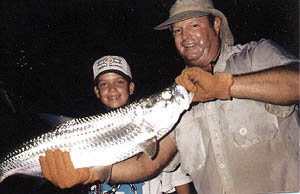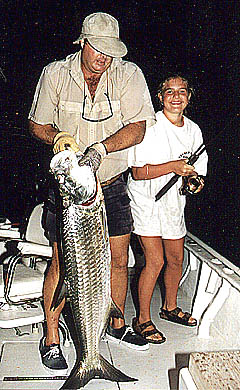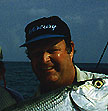
FLORIDA KEYS
TARPON FISHING AS A FAMILY ACTIVTY

Part of the
FISHING THE FLORIDA KEYS
Series
 Looking for a new and exciting family activity for the upcoming
weekend down here in the Keys? As you mull over the possibilities... a trip to the
movie theater, taking in a ball game, a picnic at the beach...consider this. Why not
combine the thrills of a Schwarzenegger flick, the challenge of participating in (not just
watching) an exciting sporting activity, and the satisfaction of being out on the water
with those closest to you. We're talking family tarpon fishing here, and what better
time to do it than during the prime months of April through June.
Looking for a new and exciting family activity for the upcoming
weekend down here in the Keys? As you mull over the possibilities... a trip to the
movie theater, taking in a ball game, a picnic at the beach...consider this. Why not
combine the thrills of a Schwarzenegger flick, the challenge of participating in (not just
watching) an exciting sporting activity, and the satisfaction of being out on the water
with those closest to you. We're talking family tarpon fishing here, and what better
time to do it than during the prime months of April through June.
A great misconception concerning tarpon fishing is that it's a sport for veteran anglers
possessing decathlon-esque physical conditioning in order to subdue a fish of daunting
size and power. Not true! It's very common during my two-a-day tarpon trips in
April through June to have at least one family group booked for tarpon fishing each
day. I also get a lot of husband and wife trips; it's not unusual to find that the
wife is as eager to battle a tarpon as the guy is. This sport is anything but a
"macho guys only club".
Tarpon can be described in a lot of ways... breathtaking leapers, line-sizzling runners, a
very special breed of fish. But first and foremost tarpon are fun! It only
makes sense to involve the whole family in an outing to catch the "silver king".
The fact that these magnificent creatures are averaging 70-80 pounds (and
frequently exceeding 100 pounds) at this time of year certainly adds an air of
anticipation and excitement not found in a lot of other activities, fishing or otherwise.
Kid Stuff ?
For those who think a large tarpon would totally overwhelm a youngster, consider this...my
oldest daughter, Christine, caught her largest tarpon to date (135 lbs.) back when she was
eleven, with no help in hooking or fighting the fish. And Islamorada guide, Kenny
Knudsen, has a daughter (Richelle) and son (K.C.) that by conservative estimates have
caught between them hundreds of tarpon. Richelle's largest, 161 pounds, was caught
when she was eight years old, and is still a MET Tournament record in the pee wee
division! K.C. followed up a few years later by catching a 153 pounder when he was
ten.
None of the youngsters mentioned above are
muscle-bound athletes...they're just plain kids who have had the opportunity to
participate in something really special. Once a young angler realizes landing a large
tarpon is more a function of technique and perseverance than of brute strength, it opens
the door to tremendous angling possibilities.
Close to Home
One of the real beauties of tarpon fishing is that one can experience the thrill of
fighting an extraordinarily large fish without the long and often bumpy ride that many
anglers in other parts of the country must endure to find a game fish comparable to the
tarpon. Florida Keys tarpon fishing is practically a backyard activity; it just
doesn't take that much effort to scoot out to one of our local bridges for a few hours of
family fun fishing. The bridges at Bahia Honda, Seven Mile, and Channels Two and
Five all have solid reputations as great tarpon haunts. Even on days when the wind
is up, it may be possible to keep your family comfortable by fishing the lee shore at the
end of the bridge where wave action is minimal. Or better yet, pick a small bridge
where the waves don't get a chance to build. Trust me on this one...some of the smaller,
lesser fished channels throughout the Keys are loaded with tarpon.
As always, the easiest way to get involved
in tarpon fishing is to book a charter with an experienced guide. He has all the necessary
gear, knows where the fish are during the various tide phases, and has access to quality
live bait. Look for a guide who is comfortable fishing with kids, and with whom you
feel comfortable having around your kids. And be aware that not all tarpon skiffs
are the same size. Many of the 16-18 ft. skiffs can only take 2 or 3 passengers, while the
mid-sized and larger craft can easily handle 4-6 people. Be sure to pick a boat large
enough to accommodate your family.
Tackle and Technique
 Standard
tackle for tarpon fishing is either a 20 lb. spinning outfit or 20 to 30 lb. conventional
gear. Terminal tackle typically consists of a 6 ft. leader of about 125 lb mono with
a short shank live bait hook in the 5/0 through 9/0 range, depending on the size of the
bait. A large black swivel connects the leader to 2 ft. of double line. The
use of a float is optional except during slack tide when it will be useful in keeping the
baits from hanging up on the bottom.
Standard
tackle for tarpon fishing is either a 20 lb. spinning outfit or 20 to 30 lb. conventional
gear. Terminal tackle typically consists of a 6 ft. leader of about 125 lb mono with
a short shank live bait hook in the 5/0 through 9/0 range, depending on the size of the
bait. A large black swivel connects the leader to 2 ft. of double line. The
use of a float is optional except during slack tide when it will be useful in keeping the
baits from hanging up on the bottom.
Live baits (mullet, pin fish, or crabs) are slung out from either an anchored or drifting
boat. Watching a tarpon chase down and devour a live mullet is one of the most spectacular
sights in fishing. During the fracas (which usually involves a lot of wild
thrashing, splashing, and liberal doses of angler adrenalin), it's important for the rod
tip to be held high until the fish actually grabs the bait. Then allow the tarpon to pull
the rod down to a position slightly above horizontal. When the weight of the fish can be
felt on the rod, the hook should be set with several sharp yanks of the rod upward.
Tarpon usually get airborne right after being hooked. This is when a camera in the
right hands can create some lifetime memories, as it captures the essence of this powerful
creature exploding from the water.
The battle may last twenty minutes...or two hours depending on the size and (believe it or
not ) the personality of the fish. Some tarpon jump themselves silly in the early
stages and come to the boat in an angler-friendly manner. Others play
"mean", and after an initial jump or two, they'll slug it out down deep.
The important thing to remember here is that we're supposed to be having fun; if a big
fish is "beating up" on a beloved family member, then by all means share the
load. Tag teams are okay when it comes to a family tarpon fishing.
Some Tips for Dad
Should this exciting activity become a habit (almost a certainty if the initial experience
is a good one), there are a couple of things a dad can do to make it easier for his wife
and kids to capture the "King". First, strongly consider buying a rod they'll be
comfortable with. Long, stiff-tipped rods may be fine for some people, but they put
a young angler at a severe disadvantage as far as leverage is concerned. That is, it's
easier for the fish to wear out an angler than for the angler to pressure the fish.
A shorter rod that features a fast taper tip will be a much more effective fighting
tool. This distributes the brunt of the pressure into the butt of the rod, allowing
an angler to pump and wind with minimal effort.
It's also possible to make the hook setting process easier by dropping down a hook size.
Perhaps even a better idea is switching to a circle hook (sized appropriately to
match the size of the bait). This will alleviate the need to ram home a big hook
into the tarpon's hard mouth (which has been often compared to the inside of a cinder
block). Instead, an angler need only wind a circle hook into the fish. Because
these special hooks are made to slide down the jawbone and roll into the corner of the
jaw, a hard hook set is unnecessary (in fact, detrimental) to the hooking process.
A decent fighting chair is a real help for those with limited arm strength; the gimbal
socket that the rod is placed in will share a good portion of the strain. If the
fish is fought from a standing position (always preferable if possible) a good quality rod
belt should be worn as low on the hips as possible to allow the angler to hold the rod at
the top of the foregrip for maximum leverage.
One more thing...tarpon don't have to be big to provide lots of fun. Smaller tarpon
are readily available at this time as well, and on tackle scaled down to match the size of
the fish, they are the friskiest, jumping-est fish an angler could ever hope for.
Some of the shallower sections of those previously mentioned bridges are good bets for
juvenile tarpon, as are many of the smaller bridges.
So if it's family entertainment you're looking for this weekend, look no further.
Whether it's a matinee or the evening show, tarpon fishing is sure to provide more
excitement and enjoyment than can be found in any theater.
Site last updated 9/8/99
![]()
 Your host, Captain Buddy LaPointe, has over
20 years experience charter fishing in the Florida Keys. A cum laude graduate of Pensacola
Christian College, Captain Buddy is professional, courteous, and dedicated to showing his
clients a great time on the water! Captain LaPointe has been featured on Mark Sosin's
Saltwater Journal, (seen weekly on national television), and in the Miami Herald. In
addition, Capt. Buddy has written numerous articles for Sport fishing Magazine, Saltwater
Sportsman, Fishing the Florida Keys and the Florida Keys Keynoter.
Your host, Captain Buddy LaPointe, has over
20 years experience charter fishing in the Florida Keys. A cum laude graduate of Pensacola
Christian College, Captain Buddy is professional, courteous, and dedicated to showing his
clients a great time on the water! Captain LaPointe has been featured on Mark Sosin's
Saltwater Journal, (seen weekly on national television), and in the Miami Herald. In
addition, Capt. Buddy has written numerous articles for Sport fishing Magazine, Saltwater
Sportsman, Fishing the Florida Keys and the Florida Keys Keynoter.
![]()
|
HOMEPAGE | ARTICLES | EMAIL/FEEDBACK |